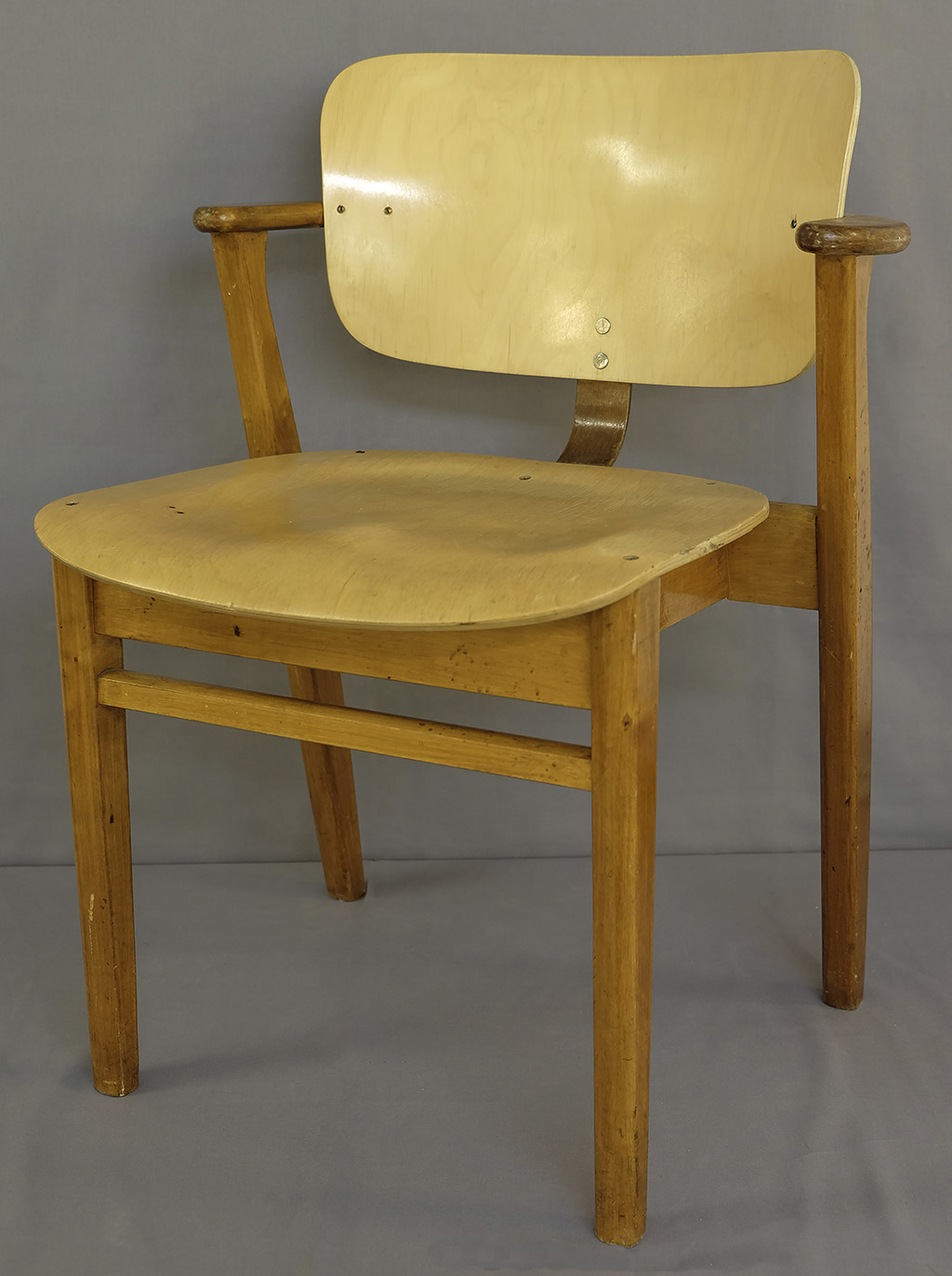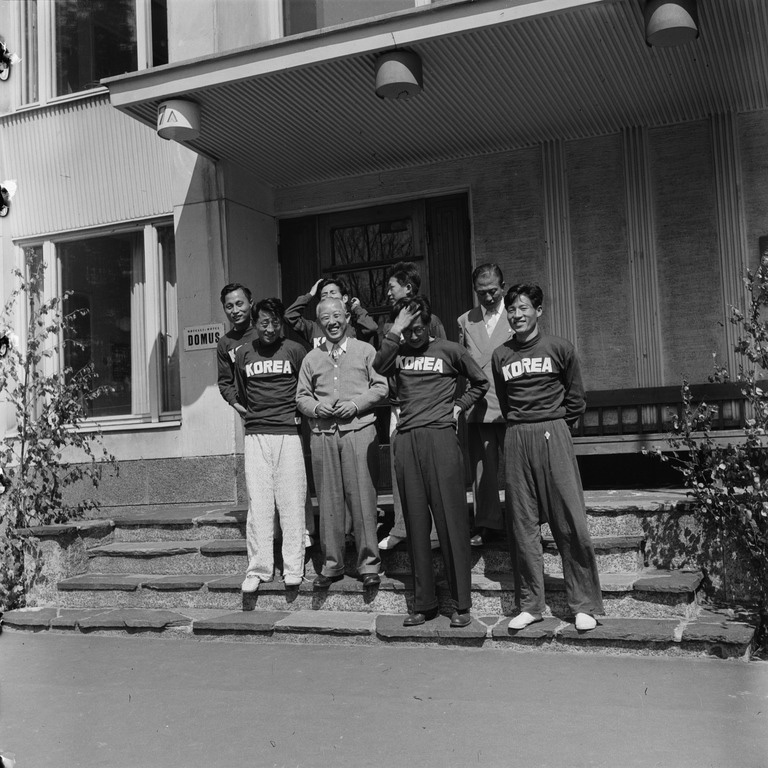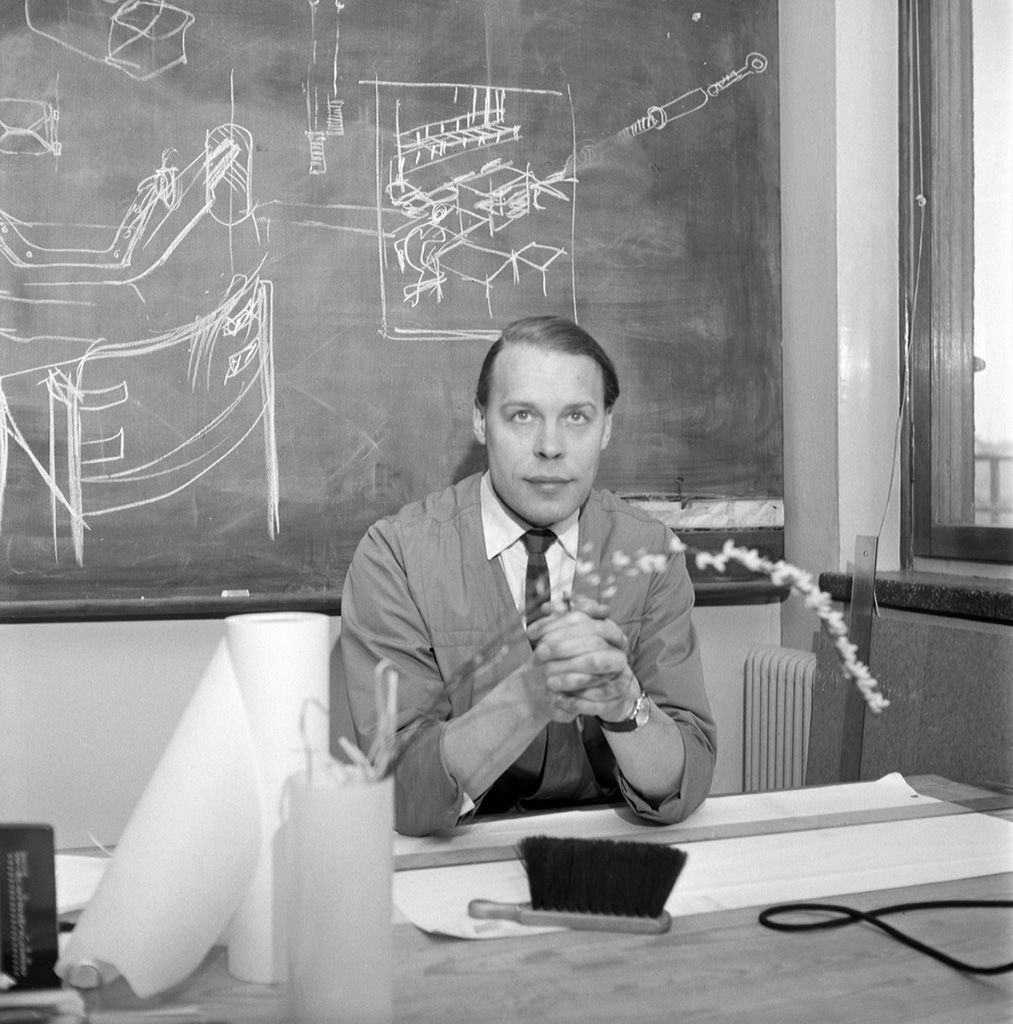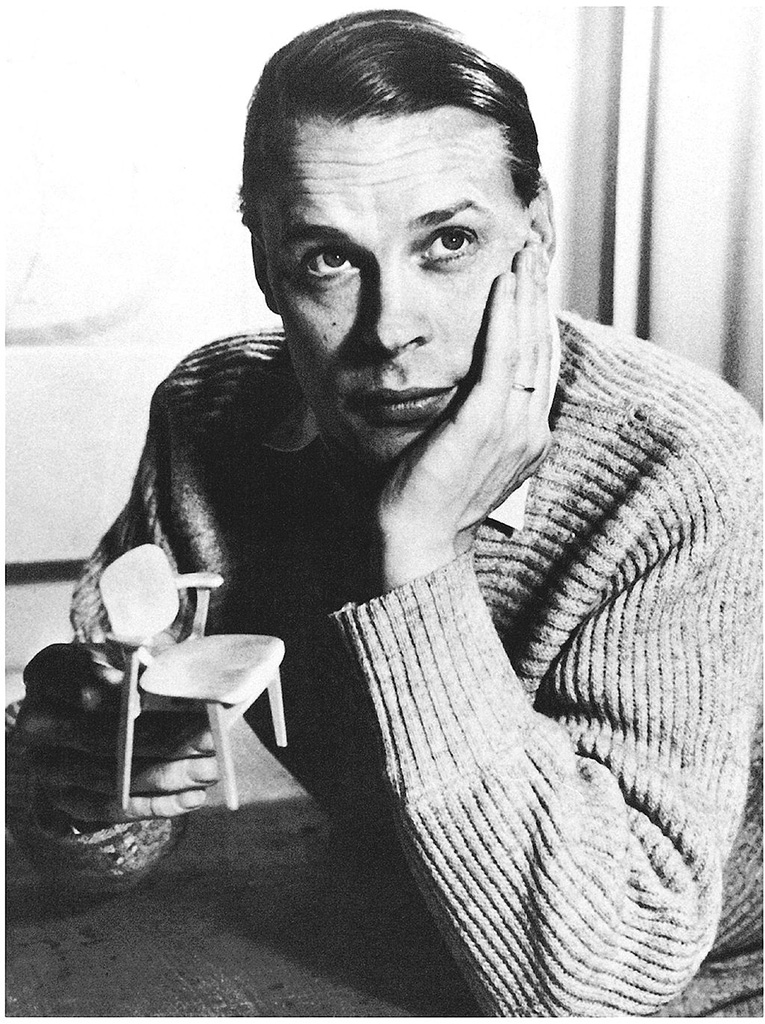The object of the month in November is a Finnish design classic: a chair which is a familiar object to many Finns from a variety of spaces. The story of the Domus chair began during the housing shortage that followed the Second World War, although it is possible that the idea for the chair occurred to its designer, Ilmari Tapiovaara, as early as the 1930s. In any case, the bent plywood chair, originally designed for a student housing complex in Helsinki, gradually became a mass-produced international bestseller. The Helsinki University Museum has received items of Domus furniture designed by Tapiovaara as donations from the University of Helsinki’s Student Union.

Domus Academica
Finnish university students had traditionally lived in sublet rooms, housing provided by private individuals and associations, or rooms in buildings constructed for specific student associations. The idea of a major student housing project was initially conceived in the 1930s when the living conditions of, in particular, university students who had moved from a different part of the country became difficult. Students fell into debt due to the high price of housing and food, and cramped living conditions led to the spread of tuberculosis, for instance.
After the war, the general housing situation grew even more difficult. To alleviate it, the government began to subsidise housing by guaranteeing developers’ loans. Finally, the Student Union of the University of Helsinki decided to improve student living conditions by constructing a housing complex on a plot in the Leppäsuo district of Helsinki, purchased from the city.

Fundraising for the construction project began with a prominent campaign. Donations poured in from all across Finland and the world, and the University of Helsinki also contributed.
The buildings were designed by architect Pauli Salomaa, and the interiors by Ilmari and Annikki Tapiovaara. The two first two Domus Academica buildings were completed in 1947, the third in 1952 and, after a pause, the fourth (Building D on Hietaniemenkatu street) in 1968. During the Helsinki Olympic Games of 1952, Domus served as accommodation for international athletes.

Who was Ilmari Tapiovaara?
Interior architect Ilmari Tapiovaara (1914−1999) was one of the leading figures of Finnish design. His designs can be found in public spaces, homes and museums around the world.
Ilmari Tapiovaara’s father Kaarlo was a Fennoman (a Finnish nationalist movement of the late 19th century) and, as a member, he had ‘Finnicised’ his original surname from Karlsson to Tapiovaara. All of the family’s 11 children were given names familiar from the Kalevala, a compilation of Finnish folk poetry. Ilmari’s (known to his family as Imma) best-known siblings were the film director Nyrki Tapiovaara, who died in the war at a young age, and the artist Tapio Tapiovaara.
Ilmari Tapiovaara studied interior design at the Central School of Applied Arts in Helsinki, where he was taught by Arttu Brummer, who had designed furniture for various developments, including the University’s Main Building. Tapiovaara’s fellow students included Tapio Wirkkala, Lisa Johansson-Pape, Kaj Franck and Dora Jung, all of whom drew inspiration from the Bauhaus style named after the Bauhaus art school founded by the German Walter Gropius. The Bauhaus approach emphasised function and the potential of industrial production to democratise the use of design products.
As a young man, Tapiovaara worked in both London and Paris, in the latter city in the office of the famous architect Le Corbusier. Thanks to his brother Nyrki Tapiovaara, he became familiar with scenography, or ‘film architecture’ as he called it, when living in London. He won several design competitions while still a student and, immediately upon graduating, was hired by Asko, the largest furniture factory in Finland, based in the city of Lahti. There he met Annikki Hyvärinen, who also worked for Asko and married Ilmari Tapiovaara in 1939.

After the Second World War, Ilmari Tapiovaara became the artistic and financial director for Keravan Puuteollisuus (‘Kerava Wood Industry’). In 1951 he mustered the courage to establish his own design office, which became a major success. Many young designers, such as Eero Aarnio, learned their trade in Tapiovaara’s office. In the 1950s Ilmari Tapiovaara served as head of the interior design department at the Illinois Institute of Technology and, while teaching, also worked in the architectural office of Mies van der Rohe.
His spouse Annikki Tapiovaara was closely involved in the interior design of Domus Academica, and the couple cooperated in writing a presentation of the building for Arkkitehti (‘Architect’) magazine. Like many women, however, Annikki Tapiovaara has been relegated to a bit part in history. The couple became estranged in the 1950s, and Annikki Tapiovaara passed away in 1972. In her obituary, Ilmari described her as the éminence grise of an important era.

Ilmari Tapiovaara designed interiors, furniture, lighting fixtures, cutlery, toys and many other objects. His works include the Leningrad (St Petersburg) concert hall, Lauttasaari Church and the interior of Finnair’s Caravelle aircraft. For the University of Helsinki, he designed interiors for the new extension of the University’s Main Building.
How the Domus chair became an international success
The starting point for the interior design of Domus Academica was challenging: all necessities had to be fitted in small rooms intended for two people, without compromising on comfort. In the post-war period, many materials were in short supply, but an abundance of Finnish birch was available. To save space, beds were designed as sofa beds, and the desk drawer also served as a bedside table. The desk chair could be partly pushed under the desk.
Ilmari Tapiovaara had been planning a type of desk chair for a long time. The chair had to be comfortable to sit in, even for long periods of time, as well as being easy to assemble and stack up. The Domus chair fit the bill: it is comfortable and, thanks to its short armrests, it is easy to pull close to the desk or table for studying or eating. The soft shapes of the bent plywood material support the body. Tapiovaara himself described the arching of the Domus chair’s back legs as a tribute to the calves of ‘young ladies’. He was annoyed when the chair was described as a ‘nylon killer’ after its splintered front edge proved disastrous for women’s nylon stockings.

The Domus chair was delivered from the factory in pieces which the end user could easily assemble. In other words, Tapiovaara’s approach was similar to Ikea’s flat pack concept. The chair quickly spread to public buildings and paved the way for Tapiovaara’s international career. The Domus chair sold well in both the UK and the US, where it was marketed as the ‘Finnchair’. After the material shortage of the post-war era eased, a cloth-covered version of the seat also began to be produced.
Today, the Domus chair is seen as a masterpiece of modern furniture design. It is extraordinary that a modest wooden chair became an international hit 70 years ago, at a time when marketing required much more effort than in our internet era.

Jaana Tegelberg, Head of Collections
Translation: University of Helsinki Language Services.
Sources
Artek, Domus Chair [website]. [Accessed on 7 July 2021.] Available at: https://www.artek.fi/en/products/domus-chair.
Kalin Kai: Tapiovaara suunnitteli malleilleen nailonintappajia. Helsingin Sanomat, 6 June 2014. [Subscription website.] [Accessed on 13 September 2021.] Available at: https://www.hs.fi/kulttuuri/art-2000002736754.html.
National Audiovisual Institute, Elävä muisti, Asuntopula sodan jälkeen [website]. [Accessed on 07 July 2021.] Available at: https://elavamuisti.fi/vuosikymmenet/asuntopula.
Klinge Matti: Ylioppilastalo. Helsingin ylipiston ylioppilaskunnan kiinteistöjen vaiheita. Helsingin yliopiston ylioppilaskunta. 1st edition 1970, 2nd edition Gummerus, Jyväskylä 1990.
Lehmusvesi Jussi: Ilmari Tapiovaara -näyttely on ”täysosuma” ja ”retroshotti” – katso kuvakooste. Helsingin Sanomat, 5 June 2014. [Subscription website.] [Accessed on 13 September 2021.] Available at: https://www.hs.fi/kulttuuri/art-2000002736726.html.
Maunula Leena: Ilmari Tapiovaara. Obituary. Helsingin Sanomat, 1 February 1999. [Subscription website.] [Accessed on 14 September 2021.] Available at: https://www.hs.fi/muistot/art-2000002626627.html.
Rinne Matti: Yksitoista Tapiovaaraa. Tuoleja, tauluja, elokuvia. Kustannusosakeyhtiö Teos. Porvoo 2008.
Svenskberg Aila (ed.): Ilmari Tapiovaara – muotoilu ja elämä. Published in connection with the exhibition Ilmari Tapiovaara 100 vuotta, 6 June–21 September 2014. Authors: Pekka Korvenmaa, Susanna Aaltonen, Suvi Saloniemi, Aila Svenskberg, Jonathan M. Woodman. Design Museum. Helsinki 2014.
Wikipedia, Arava [website]. [Accessed on 7 July 2021.] Available at: https://fi.wikipedia.org/wiki/Arava.
